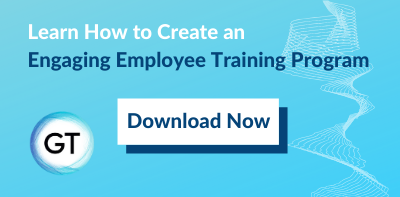Ask most employees what they think about corporate training and you are bound to get mixed responses. Some employees absolutely love the opportunity to learn new skills they can immediately apply to their jobs, while others view learning as a necessary evil for survival.
How is it possible to get employees excited about eLearning? It’s all about creating a learning environment that’s fun, interesting, and meets the learner where they are.The Intersection of Learning and Technology
Great learning design requires a couple of things to make sure it’s working for employees; good content and meaningful delivery. When these two factors intersect, the perfect conditions for employees to get excited about eLearning are created. What do we mean?
#1 - The content must be relevant, interesting, and comprehensive to the learner in order to have real value.
#2 - The learning material must be presented in such a way that the learner immediately understands its value and how it applies to their work.
When developing eLearning content, consider how people get their information today. It’s often done on mobile devices with a quick search. This is a form of immediate reward for the seeker. Evaluate your learning platform(s) and think about how the content can best be delivered to the learner to make it more exciting, tangible and useful. Does this require a challenge or a game to keep learners on their feet?
Overcoming Obstacles to Boring eLearning Content
To get employees excited about eLearning, it’s also critical to avoid bombarding them with too much information or information that can be construed as boring. Find a happy balance that gives employees just enough information that they need for a specific topic (save the over-the-top charts and graphs for another day), and content that injects a light sense of humor - where appropriate - to reduce inciting boredom. If you want to provide more detailed information, supplement your content with real-world industry scenarios or examples.
A learning platform can also cause hang-ups in the learning experience for employees. This is often why employees don’t even log in until they are given deadlines and serious consequences by management. Having a learning platform that is mobile-friendly, simple to use, and capable of hosting many different types of learning content (audio, video, interactives) is a major plus. This gives employees more variety and a sense of control over the learning process.
Where Does All This Exciting Learning Content Come From?
Keeping employees happy and looking forward to learning requires plenty of fresh and interesting content. But where does this all come from? The good news is that there are plenty of sources for learning content.
Companies may choose to continuously update their own legacy content, but brand new content may be requested from employees if and when they realize they're not getting exactly what they need to succeed. That begs the question of "buy or build?" In the absence of resources - usually time, budget and equipment - that allow you to create training components in-house, you may need to seek outside alternatives.
Like most things in life, you can find some pieces of training content for free and others for purchase. On the free to freemium side of things you have MOOC providers for full courses to incorporate into larger training programs, and then plug and play resources such as YouTube for video components to complement your written text. A wide variety of full course vendors also exist such as LinkedIn Learning (LinkedIn's purchase of Lynda.com), OpenSesame, and Pluralsight if you have the budget.
Using Documentation to Support Learning
Whenever possible, a range of supporting material can and likely should be made available to employees who are working through eLearning courses. This can include worksheets and handouts that supplement the online learning experience. For example, companies can share documents such as product manuals to support a product training. Templates and checklists for completing specific tasks are also welcomed by employees.
However, having an inclusive array of documents is just the beginning. It's also key to have written documentation that prescribes how this content is best used; some LMS's support this in-app while some organizations will use an internal Wiki of sorts that consolidates links for and instructs on the use of all of this eLearning material. In essence, think of this documentation as the employee syllabus; it provides things like guidance on who should take what trainings and in what order.
Meaningful Assessments for Employees
Assessing your employee learners is a good way to ensure they are participating in training and retaining the knowledge. Use knowledge checks to measure if they understand and can leverage what they've learned in practice. Be sure to make these assessments interesting with questions that spur further thought, and use gamification elements that challenge them. Provide constructive feedback to help them improve.
Need a little more guidance? Download our guide and you'll be well on your way to creating a stellar employee training program.






Leave a comment